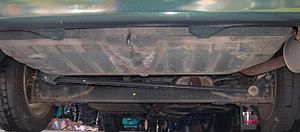Panhard staff

The Panhard rod is a chassis guide element in vehicles with a rigid axle . The simple but effective axle lateral guide was invented in France in the 1890s by Panhard & Levassor and is still used today.
function
If a rigid axle is only connected to the chassis (or body ) of the vehicle on the suspension elements at its ends or on trailing arms , the problem arises that the spring-loaded connection not only allows up and down movements, but also uncontrolled sideways movements of the axle . This worsens the vehicle's directional stability. The sideways movements are intercepted by the Panhard rod. It thus restricts one of the six degrees of freedom of the axis, since it takes over the transverse guidance of the axis. Some descriptions refer to the Panhard rod as a wishbone because of this function.
The longitudinal guidance of the axle is carried out by the leaf springs or (with helical suspension) separate trailing arms, which are similar in design to the Panhard rod.
construction
The Panhard rod rotatably mounted at both suspension points connects one side of a rigid axle with the other side of the car body. Constructively, it can be a rod, a profile or a tube.
The effect is based on the fact that the rod runs almost parallel to the axis. When the axis is moved up and down, the rod is therefore only rotated through a small angle around the suspension points. Together with the large radius of the circle he describes, this results in a small, controlled sideways movement of the axle that can be absorbed by the suspension.
Panhard bars can also be built into De Dion axles . The De Dion axle is a rigid axle based on the principle of wheel guidance, in which the differential is rigidly connected to the body in order to reduce the unsprung masses.
